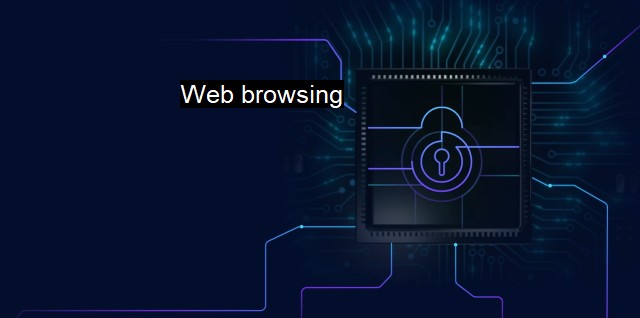What is Web browsing?
Web Browsing: Navigating the Digital Frontier Safely and Securely Amid Cyberthreats
Web browsing is a term that refers to the process of navigating through various websites, web pages, or web applications on the internet. Web browsing occurs through software called a web browser. Some of the common web browsers are Google Chrome, Mozilla Firefox, Safari, and Microsoft Edge. Each time a user interacts with such browser software to access web-based content, they're participating in the act of web browsing.The world of web browsing is incredibly diverse, with websites covering practically every imaginable topic. It allows users to access and interact with vast quantities of information dynamically. while web browsing may seem like a simple and secure activity, it potentially exposes the user to various threats in the cybersecurity landscape.
Contextually, while discussing cybersecurity and antivirus, web browsing can be a significant risk. Cyber threats are varied and evolving and they exploit vulnerabilities in a user's system or networks during web browsing. For instance, malicious sites may contain subversive elements, such as malware, ransomware, viruses, trojans, worms, and spyware. These harmful software programs or scripts are used by hackers or other bad actors to sabotage or gain unauthorized access to the users' system, steal sensitive data, disrupt operations, or even use the besieged systems for additional nefarious purposes.
Applications, attachments, plugins and even advertisements on the web might include harmful components that could steal data, ruin critical files, or open gateways for other sort of destructive activities. Emails also fall under the category of these threats as certain links or attachments in emails may lead to malicious websites. Phishing websites, which impersonate legitimate organizations to deceive users into revealing confidential information, are another prevalent threat users may encounter during web browsing.
At this juncture, the discussion on antivirus software becomes pertinent. Antivirus software is a crucial tool that serves as a protective wall against these harmful elements encountered during web browsing. It accomplishes this by continuously scanning, detecting, and eliminating threats from your system by employing signature and heuristic-based techniques.
Signature-based detection involves identifying known threats by comparing code in a system against a database of known harmful code. Conversely, heuristic-based analysis probes into suspicious activities or changes and identifies potential threats based on their behavior. This way, even if a threatening code is modified or disguised, an antivirus can still track it down and neutralize it.
Another feature of modern antivirus software is the ability to rate websites based on their security. They alert users if a potential website is dangerous, even blocking access to it entirely. It helps keep the user's system free of infections acquired from malignant web content while browsing.
Most antivirus software also provides a feature known as a firewall. A firewall controls the incoming and outgoing network traffic by analyzing whether it meets certain security criteria or rules. It acts as a barrier between a trusted network (user's system or internal network) and an untrusted one (the internet). This prevents unwanted invasions from the internet while web browsing and secures the user’s sensitive data.
Despite the multitude of threats, web browsing can be made secure with vigilant and responsible online practices and robust cybersecurity defenses, such as regular system updates and reliable, up-to-date antivirus software. It can't be stressed enough just how vital it is to have comprehensive security measures in place when performing web-based activities, most especially when web browsing. Hence, companies and individuals must take cybersecurity precautions without negotiation, for web browsing may be a commonplace activity, but the threats it draws are deadly serious.

Web browsing FAQs
What is web browsing?
Web browsing refers to the process of accessing and browsing web pages and online content via a web browser. It is a fundamental activity when it comes to accessing the internet.How can web browsing pose a cybersecurity risk?
Web browsing can pose a cybersecurity risk if the user visits malicious websites, downloads infected files, or falls for phishing scams. These can lead to the installation of malware on the user's device, theft of sensitive information, or even identity theft.Can an antivirus protect me while browsing the web?
Yes, antivirus software can provide protection while browsing the web by blocking access to malicious websites, scanning downloaded files for viruses, and detecting and removing malware from the device. However, it is crucial to keep the antivirus software up-to-date to ensure its effectiveness.What can I do to browse the web safely?
To browse the web safely, it is recommended to use a secure web browser with built-in security features such as pop-up blockers, anti-phishing filters, and privacy settings. Additionally, you should avoid clicking on suspicious links or downloading files from untrusted sources. It is also a good practice to keep your antivirus software up-to-date and to use a VPN when browsing on public Wi-Fi networks.| | A | | | B | | | C | | | D | | | E | | | F | | | G | | | H | | | I | | | J | | | K | | | L | | | M | |
| | N | | | O | | | P | | | Q | | | R | | | S | | | T | | | U | | | V | | | W | | | X | | | Y | | | Z | |
| | 1 | | | 2 | | | 3 | | | 4 | | | 7 | | | 8 | | |||||||